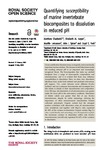Quantifying susceptibility of marine invertebrate biocomposites to dissolution in reduced pH
| dc.contributor.author | Chadwick, M | |
| dc.contributor.author | Harper, EM | |
| dc.contributor.author | Lemasson, Anaëlle | |
| dc.contributor.author | Spicer, John | |
| dc.contributor.author | Peck, LS | |
| dc.date.accessioned | 2019-06-11T16:31:30Z | |
| dc.date.available | 2019-06-11T16:31:30Z | |
| dc.date.issued | 2019-06-05 | |
| dc.identifier.issn | 2054-5703 | |
| dc.identifier.issn | 2054-5703 | |
| dc.identifier.other | ARTN 190252 | |
| dc.identifier.uri | http://hdl.handle.net/10026.1/14304 | |
| dc.description.abstract |
<jats:p>Ocean acidification threatens many ecologically and economically important marine calcifiers. The increase in shell dissolution under the resulting reduced pH is an important and increasingly recognized threat. The biocomposites that make up calcified hardparts have a range of taxon-specific compositions and microstructures, and it is evident that these may influence susceptibilities to dissolution. Here, we show how dissolution (thickness loss), under both ambient and predicted end-century pH (approx. 7.6), varies between seven different bivalve molluscs and one crustacean biocomposite and investigate how this relates to details of their microstructure and composition. Over 100 days, the dissolution of all microstructures was greater under the lower pH in the end-century conditions. Dissolution of lobster cuticle was greater than that of any bivalve microstructure, despite its calcite mineralogy, showing the importance of other microstructural characteristics besides carbonate polymorph. Organic content had the strongest positive correlation with dissolution when all microstructures were considered, and together with Mg/Ca ratio, explained 80–90% of the variance in dissolution. Organic content, Mg/Ca ratio, crystal density and mineralogy were all required to explain the maximum variance in dissolution within only bivalve microstructures, but still only explained 50–60% of the variation in dissolution.</jats:p> | |
| dc.format.extent | 190252-190252 | |
| dc.format.medium | Electronic-eCollection | |
| dc.language | en | |
| dc.language.iso | en | |
| dc.publisher | Royal Society, The | |
| dc.subject | ocean acidification | |
| dc.subject | microstructure | |
| dc.subject | bivalves | |
| dc.subject | dissolution | |
| dc.subject | crustaceans | |
| dc.title | Quantifying susceptibility of marine invertebrate biocomposites to dissolution in reduced pH | |
| dc.type | journal-article | |
| dc.type | Journal Article | |
| plymouth.author-url | https://www.webofscience.com/api/gateway?GWVersion=2&SrcApp=PARTNER_APP&SrcAuth=LinksAMR&KeyUT=WOS:000473797400028&DestLinkType=FullRecord&DestApp=ALL_WOS&UsrCustomerID=11bb513d99f797142bcfeffcc58ea008 | |
| plymouth.issue | 6 | |
| plymouth.volume | 6 | |
| plymouth.publication-status | Published | |
| plymouth.journal | Royal Society Open Science | |
| dc.identifier.doi | 10.1098/rsos.190252 | |
| plymouth.organisational-group | /Plymouth | |
| plymouth.organisational-group | /Plymouth/Faculty of Science and Engineering | |
| plymouth.organisational-group | /Plymouth/Faculty of Science and Engineering/School of Biological and Marine Sciences | |
| plymouth.organisational-group | /Plymouth/REF 2021 Researchers by UoA | |
| plymouth.organisational-group | /Plymouth/REF 2021 Researchers by UoA/UoA07 Earth Systems and Environmental Sciences | |
| plymouth.organisational-group | /Plymouth/Research Groups | |
| plymouth.organisational-group | /Plymouth/Research Groups/Marine Institute | |
| plymouth.organisational-group | /Plymouth/Users by role | |
| plymouth.organisational-group | /Plymouth/Users by role/Academics | |
| dc.publisher.place | England | |
| dcterms.dateAccepted | 2019-05-13 | |
| dc.rights.embargodate | 2019-12-18 | |
| dc.identifier.eissn | 2054-5703 | |
| dc.rights.embargoperiod | Not known | |
| rioxxterms.versionofrecord | 10.1098/rsos.190252 | |
| rioxxterms.licenseref.uri | http://www.rioxx.net/licenses/all-rights-reserved | |
| rioxxterms.licenseref.startdate | 2019-06-05 | |
| rioxxterms.type | Journal Article/Review |


